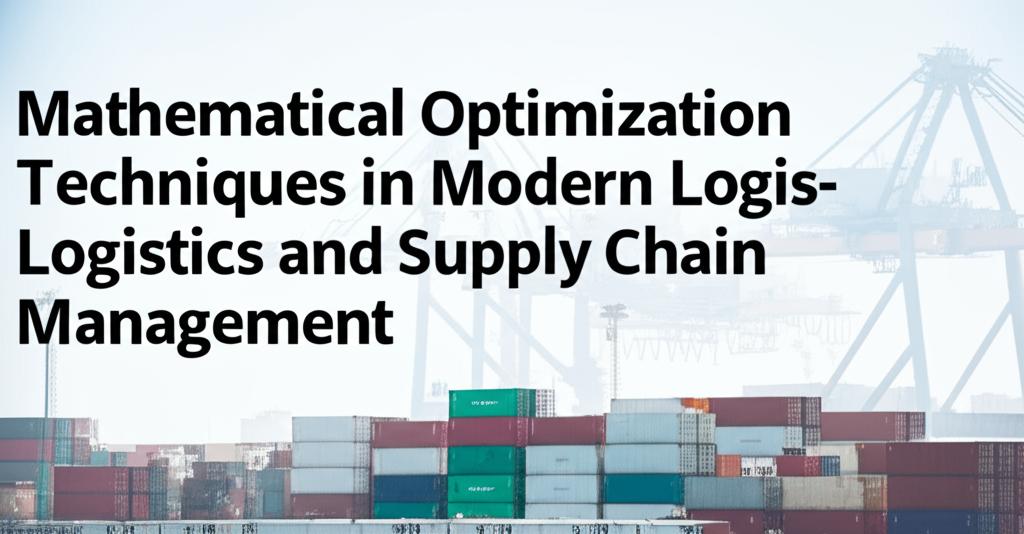Mathematical optimization is a cornerstone strategy for enhancing the efficiency and effectiveness of modern logistics and supply chain operations. At its heart, optimization in this context uses mathematical models and algorithms to systematically improve processes like transportation, inventory management, warehousing, and network design, aiming to achieve the best possible outcomes—typically minimizing costs and maximizing service delivery—within given operational constraints.
In today's increasingly complex global trade environment, marked by volatile demand, potential disruptions, and rising customer expectations for speed and reliability, supply chain optimization has become a strategic necessity. Companies leveraging these techniques can achieve significant improvements, such as reduced operational and transportation costs, better inventory control leading to lower holding costs, faster order fulfillment cycles, and improved forecast accuracy.
Foundational Mathematical TechniquesSeveral core mathematical techniques form the bedrock of logistics optimization:
- Linear Programming (LP): A fundamental technique used extensively for problems where the goal is to optimize (minimize or maximize) a linear objective function, subject to linear equality and inequality constraints. Common applications include minimizing transportation costs, optimizing production schedules, and determining cost-effective distribution strategies.
- Mixed-Integer Linear Programming (MILP): An extension of LP that allows some decision variables to be integers. This is crucial for logistics problems involving discrete decisions, such as whether to open a warehouse (yes/no), assigning specific trucks to routes, or capacity planning. MILP offers flexibility in modeling complex, real-world logistics scenarios.
- Heuristic Algorithms: When problems become too large or complex for exact methods like LP or MILP to solve in a reasonable time (NP-hard problems like the Vehicle Routing Problem), heuristics are employed. These algorithms aim to find good, feasible solutions quickly, though not necessarily the absolute mathematical optimum. Examples include greedy algorithms (like the savings algorithm for routing), local search, tabu search, genetic algorithms, and simulated annealing. They are practical and widely used for large-scale challenges.
- Combinatorial Optimization: Deals with finding an optimal object from a finite set of objects. Many logistics problems, like the Traveling Salesman Problem (TSP) and its generalization, the Vehicle Routing Problem (VRP), fall into this category.
- Simulation: Used to model and analyze the behavior of complex systems over time. Simulation allows planners to test different strategies and scenarios (e.g., network designs, inventory policies) and evaluate their performance before implementation, providing insights into system dynamics and potential bottlenecks.
Mathematical optimization is applied across various critical logistics functions:
- Transportation Management & Route Optimization: This involves determining the most efficient routes for vehicles to minimize distance, time, fuel consumption, or overall cost, while respecting constraints like vehicle capacity, delivery time windows, and driver hours. The Vehicle Routing Problem (VRP) is a classic example, with numerous variants addressing specific complexities like pickups and deliveries (VRPPD), time windows (VRPTW), and heterogeneous fleets. Advanced algorithms, often incorporating real-time data like traffic conditions, are used.
- Inventory Management: Optimization models help find the right balance between holding costs and stockout risks. Techniques are used to determine optimal inventory levels, reorder points, and safety stocks across different locations in the supply chain (multi-echelon inventory optimization) to meet demand fluctuations while minimizing capital tied up in inventory. Demand forecasting, often powered by statistical methods and machine learning, provides crucial input.
- Warehouse Optimization: Focuses on maximizing space utilization, improving labor productivity, and minimizing handling times within warehouses. This includes optimizing warehouse layout, product slotting (assigning products to storage locations), and order picking processes.
- Network Design: Strategic decisions regarding the number, location, and capacity of facilities (plants, warehouses, distribution centers) are optimized to minimize total logistics costs (including transportation, inventory, and facility costs) while meeting service level requirements.
While traditional mathematical optimization techniques remain powerful, their effectiveness is significantly amplified by modern technologies:
- Artificial Intelligence (AI) and Machine Learning (ML): AI and ML algorithms enhance optimization by improving input data (e.g., more accurate demand forecasting), enabling predictive analytics (e.g., anticipating disruptions or traffic patterns), and facilitating dynamic, real-time decision-making. AI can analyze vast datasets to identify patterns, optimize routes dynamically, and enable low-touch or no-touch planning processes.
- Big Data and Real-Time Data Integration: The availability of real-time data from IoT sensors, GPS tracking, traffic feeds, and weather reports allows optimization models to become more dynamic and responsive. This enables quicker adjustments to plans based on current conditions, improving resilience and efficiency.
- Reinforcement Learning (RL): This AI technique combines optimization with learning, allowing systems (agents) to learn the best actions to take in complex, changing environments to maximize a reward function. RL is promising for tackling dynamic supply chain problems where traditional optimization might struggle to adapt quickly enough to market shifts.
- Generative AI (GenAI): Emerging applications include streamlining workflows, aiding in compliance, and enhancing communication through virtual assistants.
- Sustainability Focus: Optimization models increasingly incorporate environmental objectives, such as minimizing carbon emissions, alongside cost and service goals. This involves optimizing routes, modes of transport (including electric vehicles), and network structures for environmental impact.
- Optimization as a Service (OaaS): Specialized providers offer optimization tools and expertise as a service, making advanced techniques accessible without requiring deep in-house expertise or complex setups.
Mathematical optimization provides a powerful toolkit for dissecting complex logistics problems and finding efficient solutions. By defining objectives and constraints mathematically, businesses can move beyond intuition or "how we've always done it" to data-driven decision-making. The integration of AI, real-time data, and advanced analytics continues to push the boundaries, enabling more dynamic, resilient, and sustainable supply chain operations. As global supply chains face ongoing pressures and complexities, the strategic application of mathematical optimization techniques is indispensable for achieving operational excellence and maintaining a competitive edge.

